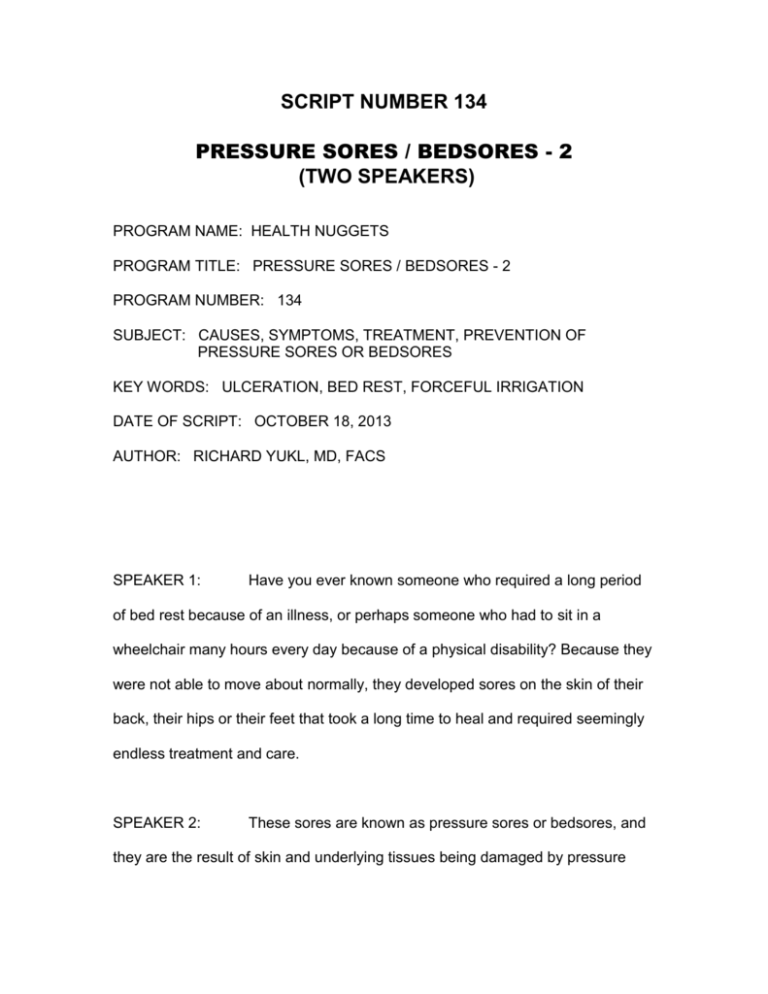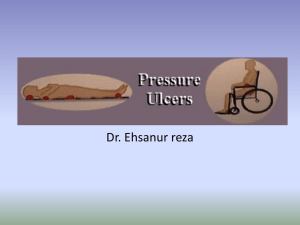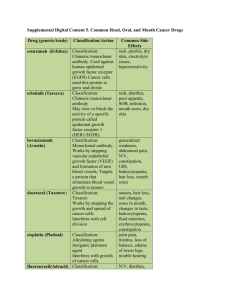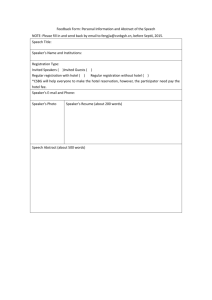script number 134 pressure sores / bedsores
advertisement

SCRIPT NUMBER 134 PRESSURE SORES / BEDSORES - 2 (TWO SPEAKERS) PROGRAM NAME: HEALTH NUGGETS PROGRAM TITLE: PRESSURE SORES / BEDSORES - 2 PROGRAM NUMBER: 134 SUBJECT: CAUSES, SYMPTOMS, TREATMENT, PREVENTION OF PRESSURE SORES OR BEDSORES KEY WORDS: ULCERATION, BED REST, FORCEFUL IRRIGATION DATE OF SCRIPT: OCTOBER 18, 2013 AUTHOR: RICHARD YUKL, MD, FACS SPEAKER 1: Have you ever known someone who required a long period of bed rest because of an illness, or perhaps someone who had to sit in a wheelchair many hours every day because of a physical disability? Because they were not able to move about normally, they developed sores on the skin of their back, their hips or their feet that took a long time to heal and required seemingly endless treatment and care. SPEAKER 2: These sores are known as pressure sores or bedsores, and they are the result of skin and underlying tissues being damaged by pressure that is applied to an area of the skin for a prolonged period of time. Today, we want to talk about pressure sores and how they can be prevented. SPEAKER 1: What is the mechanism that causes pressure sores? SPEAKER 2: The mechanism is straightforward. Skin and its underlying tissues are nourished by oxygen in blood that is delivered through small blood vessels located just under the skin’s surface. Pressure can squeeze these vessels closed when the skin is trapped between a body part and a hard surface such as a bed or a wheelchair. Then, oxygen can no longer be delivered to the tissues, the cells suffer damage, and they begin to die. Pressure sores most often develop in skin that covers the bony body parts of people who have a limited ability to move because of a medical condition. The sores can develop quickly. They are often difficult to treat, and they can take a long time to heal. SPEAKER 1: Describe some medical conditions that are risk factors for developing pressure sores. SPEAKER 2: Any condition that limits a person’s movement is a risk factor for the development of a pressure sore, and while confinement to bed or the need to use a wheelchair create the greatest risks, other risk factors include medical conditions such as being weak because of poor health or a prolonged loss of consciousness due to a brain injury. Injuries that cause a loss of sensation are risk factors because the person cannot feel pressure being applied to skin that is numb. Aging is yet another risk factor. Older adults have thinning skin, and new skin cells are generated more slowly than in the young. Having poor nutrition is a risk factor because the skin thins, and the person lacks the calories and proteins needed to maintaining good skin health. Anyone who has a risk factor for developing pressure sores increases that risk by smoking. Their pressure sores will not only be more severe, they will also be slower to heal because the nicotine in tobacco decreases blood flow, and it reduces the amount of oxygen the blood can carry. SPEAKER 1: What kind of complications can pressure sores cause? SPEAKER 2: Complications can be life threatening. The damaged skin of a pressure sore can die and be shed, leaving an ulcer that can then become infected. This allows bacteria to enter the bloodstream, spreading infection throughout the entire body. The infection can also spread directly to the bones and joints deep to the ulcer, reducing their function and causing damage that sometimes cannot be repaired. SPEAKER 1: How should I treat a pressure sore? Can I help it heal? SPEAKER 2: If it is treated early and adequately, it will often heal in several weeks to months. On the other hand, a neglected pressure sore is much harder to treat, and healing may prove difficult. Open ulcers may even require surgical repair. The first step in treatment is to relieve the pressure that caused the problem. People who are not mobile need to be repositioned at regular intervals. The person who is capable of movement needs to change their position approximately every 15 minutes, and people at complete bed rest should change positions at least every two hours, even if they need the help of a caregiver to do so. SPEAKER 1: So, step one is to relieve pressure from the damaged area. How do I treat an actual ulcer if one has developed? SPEAKER 2: Once the continuing pressure is relieved, the wound needs to be cleansed of damaged, infected or dead tissue. Dressings placed over an ulcer will absorb moist debris from the base of the wound, allowing the debris to be lifted from the depths of the wound as the dressing is removed. Sometimes, dead tissue can be removed by forceful irrigation using water in a pressure syringe or a whirlpool bath. At other times, a doctor may need to cut away dead tissue to clean the ulcer. Whatever means is used to clean the wound, once it is clean, it must be kept clean using wound dressings changed on a regular basis. God created us with a wonderful built-in mechanism that will heal a clean pressure sore, but we must make the environment right for the healing to occur. SPEAKER 1: It sounds as though pressure sores are easier to prevent than they are to treat. SPEAKER 2: Absolutely. It is easier to prevent this unfortunate condition than it is to treat it. When caring for someone with physical limitations, remember that their inability to move about normally increases their risk of developing pressure sores. Paying attention to details is the key to preventing pressure sores from forming. Various cushions and pads can help to relieve pressure points, protecting the bony areas of the body, but despite that, at risk people need to change positions frequently, even if they need assistance to do so. Taking the proper precautions will allow the body to repair tissues that are beginning to be injured and prevent ulcers from forming. SPEAKER 1: Health Nuggets is written by Dr. Richard Yukl, a medical doctor working in the United States. The medical views expressed in this program are his and may differ for your particular health needs. If you need medical advice, please consult a medical professional in your area.







